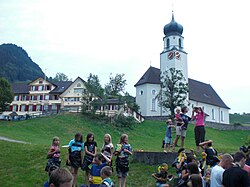Schwende District
|
Schwende District Bezirk Schwende |
||
|---|---|---|
| District | ||
 |
||
|
||
 |
||
| Coordinates: 47°18′N 9°26′E / 47.300°N 9.433°ECoordinates: 47°18′N 9°26′E / 47.300°N 9.433°E | ||
| Country |
|
|
| Canton |
|
|
| Capital | Appenzell (town) | |
| Area | ||
| • Total | 57.5 km2 (22.2 sq mi) | |
| Elevation | 838 m (2,749 ft) | |
| Population (December 2015) | ||
| • Total | 2,159 | |
| • Density | 38/km2 (97/sq mi) | |
| Time zone | CET (UTC+1) | |
| • Summer (DST) | CEST (UTC+2) | |
| Postal code | 9057 | |
| SFOS number | 3105 | |
| Municipalities | Appenzell Innerrhoden has no municipalities | |
Schwende District is a district in the canton of Appenzell Innerrhoden in Switzerland.
In the 12th century the name was recorded as Swendi or swandjan. This is a derivate of the German expression schwinden machen (wood clearing).
Schwende first came into existence between 1204 and 1220.
Schwende has an area, as of 2011[update], of 57.5 square kilometers (22.2 sq mi). Of this area, 48.1% is used for agricultural purposes, while 32.2% is forested. Of the rest of the land, 2.1% is settled (buildings or roads) and 17.6% is unproductive land.
The district covers the portion of the half-canton which lies south-west of the Sitter river. It includes the settlement of Schwende as well as the western portion of Weissbad which is between the Sitter and south of the Brüelbachs. It also includes the village of Wasserauen as well as the majority of the Alpstein mountains to the peak of Mt. Säntis.
The blazon of the municipal coat of arms is Azure a Castle Argent windowed Sable and roofed Gules issuant from a Mount of 3 Coupeaux Vert with a bandlet wavy Argent.
A silver castle stands on three green mountains. The three mountains are horizontally traversed by a silver waived beam. The background is blue. The coat of arms refers back to the Schwende Castle located in this village, but destroyed at the beginning of Appenzell's liberation wars.
Schwende has a population (as of December 2015[update]) of 2,159. As of 2008[update], 6.9% of the population are resident foreign nationals. Over the last 10 years (1999–2009 ) the population has changed at a rate of 7.3%. It has changed at a rate of 5.4% due to migration and at a rate of -0.1% due to births and deaths.
Most of the population (as of 2000[update]) speaks German (1,816 or 93.9%), with Serbo-Croatian being second most common (32 or 1.7%) and Italian being third (15 or 0.8%). There are 5 people who speak French and 3 people who speak Romansh.
...
Wikipedia

